|
Mines, Mosquitoes and Multicolour: an Adventure in Madagascar
by David Weinberg
E-mail this article to a friend
Multicolour.comís Bangkok-based partner David Weinberg has just returned from a fact-finding visit with his family to Madagascar where he discovered at first hand the realities of life in a country famed as one of the worldís most prolific sources of gemstones.
Madagascar is an extraordinary country – vibrant, exciting, frightening and fun, all at once. And there are gemstones, everywhere!
Touching down on in the Multicolour Single Engine Beechcraft airplane at Andelamena was an experience in itself, as Andelamena International is a grass field with a 385 yard runway. Easy to land but hard to take off. The French pilot Michele is experienced but even with the three of us, it would be hard to take off from the short runway so we had to dump most of the gas.
Scary plane rides are all in a dayís work for my partner Werner, and I have to admit I was more worried about the mosquitoes than anything. African stories about malaria had me worried and then my friend Arnold told me about the German tourist in Tulear who died of encephalitis and how mosquitoes were the most dangerous animals imaginable. My older daughter, who didnít really want to go to Madagascar anyway, told me they had Ebola too – I believed her of course. And get this – they still have cases of bubonic plague.
We went there anyway, despite the worries, and it was fascinating. A 226 square mile island in the Indian Ocean to the east of Africa with just 15 million people living there.
We arrived in the capital, Antananarivo (Tana), after the long flight from Bangkok and Singapore with a stop at the tiny French island of Reunion. Customs were about the same as other third world countries – disorganized, confused, generally disinterested, and looking for handouts.
We donít speak much French so I was happy that Werner came to meet us at the airport. There were mosquitoes in the airport too. Werner offered us a place to stay but there were mosquitoes there as well, so we decided to try the Hilton. We had a business card from another Swiss guy who must have been a big shot because we got a 50% discount after some minor haggling and trying the old "Iím a travel agent" trick.
It wasnít long before the real adventure began, with our visit to the mines at Andelamena, only a plane ride, but a million miles away from the Hilton.
The new deposit is actually about 85 kilometers north of the village. Most of the sellers were either miners or middlemen who had walked the 85 kilometers to sell us the rubies. Like most parts of Madagascar, there are no roads so walking or flying are the only options.
As usual there was a big line in front of the Multicolour hut. With 20 years experience buying in the bush, Werner knows the huts have to be specially designed with a separate entrance and exit, and strong enough to withstand all the pushing and shoving.
The buying was great – excellent quality for the price. The ruby was a bit violet but the sizes were good and the material looked quite clean. Many of the pieces would yield rubies over a carat and some could make more than three or four carats. I have yet to see the cut stones but Werner says they burn well and the Thais like to buy it if they can.
When I arrived, the police or army guys were there to chase all the Thai gem dealers away, but we must have had the right connections because they didnít bother us.
The long line-up to sell to us quickly developed a party atmosphere, with blasting Malagasy music, tape sellers, and people selling ice cream.
We bought for three or four hours and went through 20 or 30kgs of cash. Yes, kilograms – the cash is heavier than the stones! Werner looked at all of the stones and we bought between 60 and 90 percent of what was offered. No time for bargaining, Werner tells them the price and itís ´yes´ or ´no´. No second chance. Our offers are good and they sometimes come away with more than they expect. But if they show the same stone twice or try to show another parcel with out agreeing on the first one, they get short shrift from the inimitable Werner, and often a light tap on the head with his flashlight!
The plastic bags they carry the stones in are something else. Theyíve been repaired with scotch tape a thousand times and they donít even look like a plastic bag anymore. I ask Werner: "Why donít they have plastic bags?" He says the tape is cheaper, or they just donít have any plastic bags. Strange, so many rubies, but no plastic bags to keep them in.
The next day we took "Mad Air" down to Tulear [Toliara??] while the Multicolour shuttle flew down to Ilakaka. With space for a bodyguard, a pilot, the buyer and the 40kgs of cash we had to rent a car and would rendezvous the next day.
After all that excitement at the mine it was time for a couple of peaceful days on the beach at Ifaty Ė we ate seafood, including stingray, and saw a bit of everyday Madagascar life. We went snorkeling over the beautiful coral, and my wife Na, who is an artist, had time to paint some of the local scenery. Just the birds singing and the crickets chirpingÖNo success on the fishing trip though!
We savored the fresh air after the smoky atmosphere of Antananarivo, where a lot of charcoal is burned for cooking. The Yamabalaya mixed seafood was excellent, and there was even chilli sauce, much to the delight of Na.
And just enough time for the girls to check out the shopping – batiks, shells and local crafts, and for Na to do some painting, despite the unwanted attentions of curious locals.
I was still worried about the mosquitoes, but fortunately they were scarce. We met with Clement, one of our well-connected local partners, and drove up to Ilakaka. The drive was uneventful with the odd baobab tree adding to the excitement for us. It looked like New Zealand, reckoned Na. The road was pretty good with few cars but more ox carts and plenty of the locals just walking.
Coming from Thailand, we were all elated to find a Thai restaurant right there in the middle of nowhere near Ilakaka. We had a quick look at the town and went back to the Thai restaurant/hotel to stay for the night. The Thais were out there in the high desert practicing their golf and partying as usual. We all ordered the Thai seafood noodles and my younger daughter Danielle ordered the crab. She always likes crab. It was cold and very windy in the high desert Ilakaka plain, much colder than I expected for a tropical country.
Next day we were in the official buying area, buying again. The government tries to control the business but in general they are hardly involved and free market forces flourish, distributing cash to the miners and diggers, who in turn redistribute it throughout the country with a multiplier effect which can only be good for such an impoverished nation.
As usual the line to sell was long. They start queuing as soon as the plane arrives. Indeed, even if you donít have stones, your place in the line is worth money and it can be sold. The security is there mostly for crowd control – five or six army guys with guns, and a couple of police as well as the regular Multicolour black belt bodyguards, trying to prevent the stampeding. Itís not the danger of robbery, itís more the pushing and shoving of hundreds of over-eager locals anxious to sell to Multicolour because the prices are fair and because we buy all kinds of stones and every quality. The line has rules and the security team is there to see that they are enforced. Women and children come first, everyone gets a chance to show; if you want to bargain, go back to the end of the line; and donít get caught showing the same stone twice. Sometimes they even dig under the fence to try and cut the queue!
At one point the crowd was really pushing and I thought the hut was going to give way with my kids inside. My teenage daughters didnít want to walk around outside and didnít appreciate the attention. One Madagascan lad tried to hold my younger daughterís hand, which terrified her, and she stifled a cry. I donít think there was any danger, theyíre all just there for the money, but she probably thought otherwise.
Trust is the key, especially as many of the sellers donít know the price. It was amazing – when we arrived there were ten or more shops open for buying. After a few minutes all the other buyers cleared out Ėit was pointless for them to even attempt to buy as the entire crowd was lined up for Werner. The prices are good and we buy all. Whatís a miner to do with the stones he canít sell? Put them back in the mine?
Finished with that line, we were off again. The girls had had enough anyway. That night we stayed at Les Renes De LíIsalo a beautiful hotel built into the unique rock formations in the Ilakaka area at Isalo National Park. It was a welcome respite and the girls surely appreciated the clean accommodation, while Na thought it was stunning. "It looked like a palace," she said.
Werner flew off for more buying in the capital and we took the scenic route – 703 km from Ilakaka to Antananirvo, or rather 14 long tortuous hours off twists and turns. The "Long and Winding Road" to be sure.
Fianaratsoa was a milestone of sorts with the old combination French-Chinese style hotel serving as our accommodation for two nights while we went sightseeing to Ranomafana National Park. The road was really bad and it took four hours to negotiate the 120 km round trip. The waterfalls were well worth the trip, however, but we didnít see any of the lemurs the island is famed for. There was also plenty of opportunity for Na to paint as well, and a spot of shopping for crafts and a very nice chess set.
On Sunday we drove the last 405 kilometers. The locals seemed to like hats from the 50ís and were all dressed up in the Sunday-best for church. Antsirabe was another highlight with some interesting colonial architecture and generally nice scenery. It seems to be a manufacturing area but they still have cholera and I was worried about that.
I always like a big meal and we had a wonderful fondue bourguignon the last night before the return flight. I tell my wife: "We need carbohydrate loading for marathon airplane flights."
Customs seemed like they wanted kickbacks for anything Ė even the wooden chess set we bought. Back to reality, I suppose, until the next time...
|
|
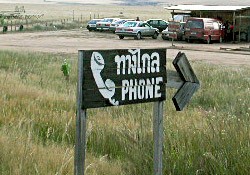
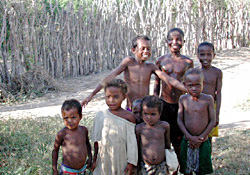
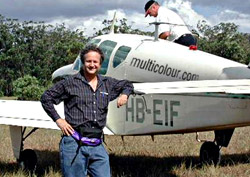
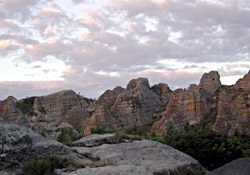
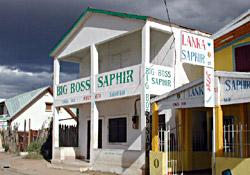
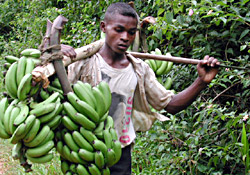
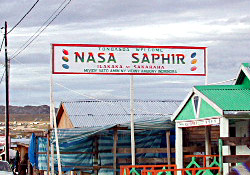
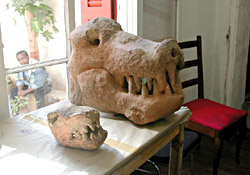
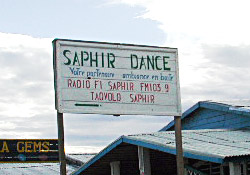
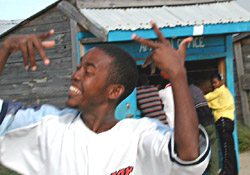
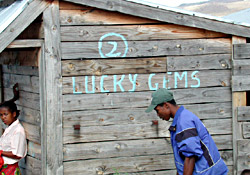
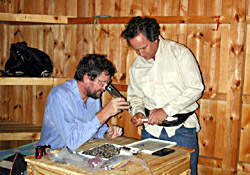
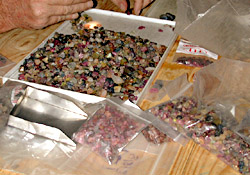
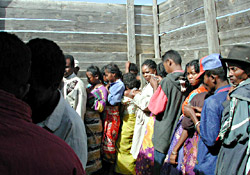
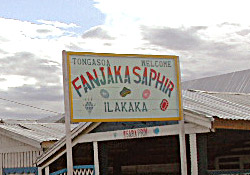
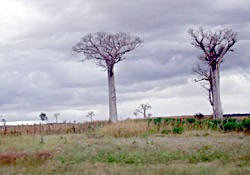
|
|





